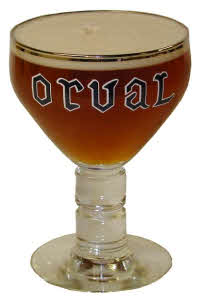Originally published in What’s Brewing July 2005
Origin: Villers-devant-Orval, Luxembourg province, Belgium
ABV: 6 per cent
Buy from specialist suppliers
Website www.orval.be
Orval is one of the world’s most unusual and distinctive ales as well as one of its finest. It’s one of the family of Belgian beers brewed under the supervision of Trappist monks, but even among this select band it stands out as something different and special.
The monks of Orval, in the attractive wooded countryside of the Ardennes, concentrate on only one beer, which eschews the plump, fruity sweetness of most Trappist brews in favour of a comparatively low gravity and a big hop accent achieved, unusually for Belgium, by dry hopping.
Commercial brewing dates from 1931. The distinctive art deco design style of the bottle, label and glass has survived almost unchanged since then: though delightfully retro today, in its time it would have been as audaciously uncompromising as the beer.
A dash of caramalt colours a mainly pale malt mash, with local spring water and Bavarian Hallertau and Czech Styrian Goldings hops. Primary fermentation is with a pure cultured yeast, but a more complex mix including some wild yeast strains is then used for a three week secondary fermentation. The beer is bottled unpasteurised with priming syrup and matured for a further five weeks before release.
Even drunk young, the result it is bursting with complex aromas and flavours that are perfect to enliven a warm summer night. Resist the temptation to chill: it’s best served at cellar temperature (10-15°C) and the brewery recommends pouring without the deposit, then adding it later if wished.
The beer pours a rich peachy amber, with a thick smooth off-white head and a spicy aroma rich in hops and kumquat orange scents. It’s thick-textured on the palate but not sweet, with big pepper hops and deep, fecund herb flavours, a trace of leather and tobacco, a dash of acidity and a trace of warming alcohol.
A lively bead turns milky on the swallow, leading to a dryish and very peppery finish. Rootier notes emerge over a long development, with traces of sweet fruit, rolling tobacco, cloves and sulphur.
It can also be cellared for up to five years and becomes even more intense and complex as it ages: on a two-year-old bottle I noted intoxicating sandalwood incense on the aroma and a fantastically complex palate with more developed notes of fennel, cloves and fresh fruit marmalade. Sappy, bitterish Indian spices stood out in the finish.
If ever there was a beer with which to challenge the wine snob, then it’s this one, but perhaps we should be careful – a wine that could match Orval in complexity would most likely cost ten times as much!
Read more about this beer at ratebeer.com:






Leave a Reply